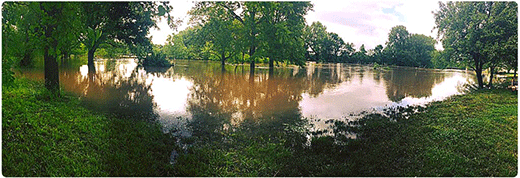
Prolonged exposure to flooding can damage trees. Consult a certified arborist to assess tree damage and treatment. | Download photo
Flooding in Kansas causes concerns over impact on trees
The Kansas Forest Service warns that Kansans should check trees for three major concerns after a flooding event
June 14, 2019
MANHATTAN, Kan. – Heavy rains in much of Kansas have caused localized flooding in some areas this spring, and one of the results has been concern over the impact on trees.
“There are three major concerns when it comes to trees and too much rain,” said Ryan Armbrust, forest health and conservation forester with Kansas Forest Service. “First is the immediate destabilization of the tree caused by saturated soils or soil erosion. Second is the deposition of significant amounts of silt on the root system. Third is the duration of flooding.”
Trees that suddenly begin to lean or even fall over due to the force of high water, wind or soil erosion should be treated as a hazard if they are near people or structures, Armbrust warns. An assessment by a certified arborist is likely justified, especially for large trees.
High water may also deposit a significant amount of silt on the root system of a tree.
“If more than an inch of silt is deposited, then some careful removal of that silt will benefit the tree,” said Armbrust. Burying the root system beneath a heavy layer of silt will reduce the root system’s ability to exchange gases and negatively affect the tree.
The duration of flooding or of saturated soils will have a direct impact on a tree’s ability to recover. This is largely dependent on tree species. Most trees will recover from being inundated for less than a week, especially if the water is flowing instead of stagnant.
Trees most sensitive to short-term flooding include redbud, walnuts, mulberry, upland oaks, most pines and conifers such as spruce and Eastern redcedar.
Honeylocust, elm, birch, and lowland oaks are more tolerant, surviving even a few weeks of flooding and saturated soils.
“The most tolerant trees include typical riparian forest species such as maples, pecan, hackberry, persimmon, ash, sycamore and cottonwood,” Armbrust said. “Baldcypress and willow are perhaps the most tolerant of all.”
Regardless of species, though, some care must be taken to help trees maintain vigor and reduce stress after flooding.
“Almost all species will have some dieback of the root system due to lack of soil oxygen, reducing the tree’s ability to take up water later in the season, so supplemental irrigation in the hot, dry days of summer will help your trees continue to flourish after the flood,” Armbrust said.
For additional information on tree health and selecting an arborist, visit kansasforests.org.


